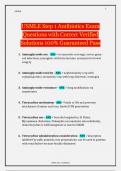1
USMLE
USMLE Step 1 Antibiotics Exam
Questions with Correct Verified
Solutions 100% Guaranteed Pass
1. Aminoglycoside use - ANS ✓no anaerobe coverage; severe gram -
rod infections; synergistic with beta lactams; neomycin for bowel
surgery
2. Aminoglycoside toxicity - ANS ✓nephrotoxicity (esp with
cephalosporins), ototoxicity (esp with loop diuretics), teratogen
3. Aminoglycoside resistance - ANS ✓drug modification via
transferases
4. Tetracycline mechanism - ANS ✓binds to 30s and prevents
attachment of amino-acyl trna; limited CNS penetration
5. Tetracycline use - ANS ✓borrelia burgdorferi, H. Pylori,
Mycoplasma. Rickettsia, Chlamydia (accumulates intercellularly);
demeclocycline is ADH antagonist so used in SIADH
6. Tetracycline administration consideration - ANS ✓absorption
inhibited by milk, antacids, iron preparations; can be used in patients
with renal failure because fecally eliminated
USMLE Step 1 Antibiotics
, 2
USMLE
7. Tetracycline toxicity - ANS ✓GI distress, teeth discoloration,
inhibition of bone growth in children, photosensitivity
8. Tetracycline resistance - ANS ✓decreased uptake or increased
efflux
9. Macrolide drugs - ANS ✓erythromycin, azithromycin,
clarithromycin
10. Macrolide mechanism - ANS ✓binds to 50s subunit and
blocks translocation (binds to 23s RNA)
11. Macrolide use - ANS ✓atypical pneumonias (mycoplasma,
chlamydia, legionella), uris, stds, gram positive cocci (in pts allergic
to penicillin), Neisseria
12. Macrolide toxicity - ANS ✓prolonged QT, GI discomfort, acute
cholestatic hepatitis, eosinophilia, skin rashes, increases serum
concentration of theophylline’s and oral anticoagulants
13. Macrolide resistance - ANS ✓methylation of 23s binding site
14. Chloramphenicol mechanism - ANS ✓binds to 50s ribosome,
inhibits peptidyltransferase activity
15. Chloramphenicol use - ANS ✓meningitis (H flu, Neisseria
meningitis, Strep pneumo)
USMLE Step 1 Antibiotics
, 3
USMLE
16. Clindamycin mechanism - ANS ✓binds to the 50 S ribosome,
blocks peptide bond formation (bacteriostatic)
17. Clindamycin use - ANS ✓anaerobic infections in aspiration
pneumonia or lung abscesses
18. Clindamycin toxicity - ANS ✓pseudomembranous colitis,
fever, diarrhea
19. Sulphonamide mechanism - ANS ✓PABA antimetabolites
inhibit dihydropteroate synthetase; inhibit bacterial folic acid
production (bacteriostatic)
20. Sulphonamide use - ANS ✓gram positive, gram negative,
Nocardia, chlamydia, simple UTI, also opportunistic infection
prophylaxis in HIV patients
21. Sulphonamide toxicity - ANS ✓hypersensitivity reactions,
hemolysis in G6PD deficiency, nephrotoxicity, photosensitivity,
kernicterus in infants, displaces warfarin and other drugs from
albumin binding
22. Sulphonamide resistance - ANS ✓altered bacterial
dihydropteroate synthetase, decreased uptake or increased PABA
synthesis
23. Trimethoprim mechanism - ANS ✓inhibits bacterial
dihydrofolate reductase (bacteriostatic)
USMLE Step 1 Antibiotics




